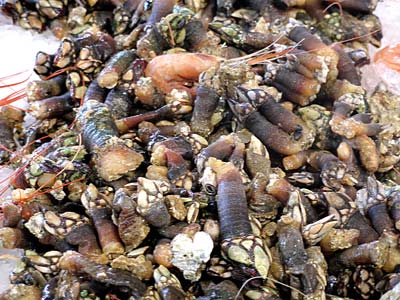Goose barnacles attach themselves to logs, the bottoms of ships, rocks, any surface which is constantly submerged. I watched a delightful television programme with Billy Oddy, in which he talked about a log which had drifted up on to a beach in the Scilly Islands. It was covered in silvery, shimmering goose barnacles. He said that he had never seen a goose barnacle before, and that was because they were normally deep under the sea. He then lifted a single goose barnacle away from the hoard, showing a long and muscular "foot" - the edible part. As he lifted it, it became clear that it looked for all the world like the neck and head of a delicate goose. He went on to explain that the Victorians had believed that, when geese set off on their migrations, they were actually travelling into the oceans, and that these goose barnacles, when they hatched, became geese and flew to land. There is, he reminded us, a goose called the barnacle goose. The tough neck is cooked in its skin, which should be peeled off before eating. Sometimes a small amount of orange liquid is released at this stage.
